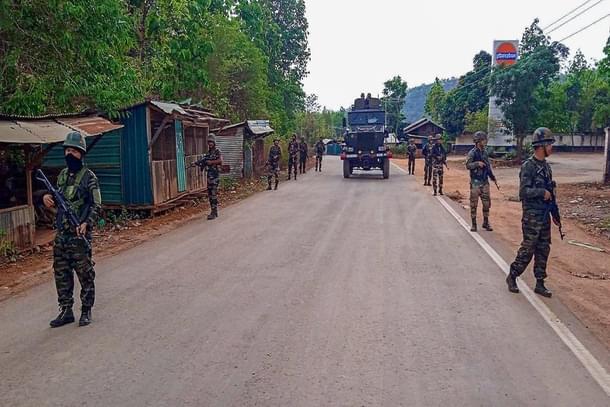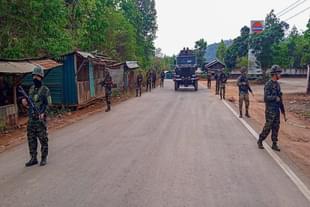Analysis
Manipur Ethnic Strife: Decoding The Latest Incidents Of Violence
Jaideep Mazumdar
Jul 03, 2023, 05:12 PM | Updated 05:19 PM IST
Save & read from anywhere!
Bookmark stories for easy access on any device or the Swarajya app.


Khoijumantabi village in Moirang subdivision of Manipur’s Bishnupur district was the latest flashpoint in the continuing ethnic strife in the state that has, according to estimates, claimed 130 lives so far.
A clash between Meiteis and Kukis in the outskirts of Khoijumantabi Sunday (2 July), as well as the nearby villages of Langza and Cananphai, left three Meiteis and one Kuki dead, and a few people from both the communities injured.
The Meiteis died of gunshot wounds while the Kuki man was beheaded. Five Kuki villagers were also allegedly taken hostage by Meitei militias.
Last Thursday (29 June), two members of a Meitei militia group died and two were severely injured when they tried to raid the Kuki-inhabited Haraothel and the neighbouring villages — K Munlai and Bethel. These three villages fall in Kangpokpi district.
On 24 June, Meitei militiamen armed with sophisticated weapons looted from police armouries attacked Kuki-inhabited Itham and neighbouring villages in Imphal West district and engaged in gunfire with security forces.
These three latest flashpoints have one thing in common: all are located in the peripheries of the Meitei-dominated Imphal Valley and in the foothills.
These areas — the peripheries of Imphal Valley that merge with the hills surrounding the Valley — have had a mixed population of Kukis, Nagas and Meiteis.
Many of these mixed population villages have been abandoned by their Kuki and Meitei inhabitants who have sought shelter in safer areas.
But there are still many villages that are still populated by Kukis or Meiteis. Meiteis, or Kukis, form the large majority of such villages and, hence, have not fled to other places.
And it is these villages that have become the targets of Meitei militias or Kuki militants. What makes these villages easy targets is that they are not well accessible and have very poor road links.
Also, almost all these villages are surrounded by forests that provide easy cover to the militias or militants. Another major factor is that these Kuki or Meiti villages lie outside the grid of the Army and Assam Rifles
“There are countless Kuki or Meitei-inhabited villages and hamlets in the foothills surrounded by forests and accessible only through foot tracks or very bad roads. It is impossible to keep watch over every such village or hamlet,” an officer posted at the headquarters of Assam Rifles (South) at Mantripukhri in Imphal told Swarajya.
The forests provide an easy getaway to the militants and militias. “Many of those who have been attacking the villages inhabited by the other community have been residents of those villages or nearby villages. They know the terrain and forest routes very well and can thus easily strike and escape,” the officer added.
There are no Kukis left in Imphal city and surrounding Meitei-dominated towns and villages of Imphal Valley. Likewise, there are no Meiteis left in the Kuki-dominated towns and villages of the hill districts like Churachandpur and Kangpokpi.
This complete exchange of population — exodus of all Meiteis from Kuki-majority areas in the hills and Kukis from Meitei-dominated areas in the Imphal Valley — has automatically and by default halted attacks by radicals of both communities on each other.
“There have been no attacks on Meiteis on the hills or Kukis in Imphal Valley because there are no Meiteis or Kukis left in those respective areas. But the peripheral areas of Imphal Valley that have Kukis and Meiteis living quite in isolation have become vulnerable now,” an officer with the Army’s 57 Mountain Division based at Leimakhong in Imphal Valley told Swarajya.
“We cannot spread our forces out thinly and it is impossible to have static posts to keep vigil on every inch of the peripheral areas. Because of their remoteness and poor accessibility, even regular patrolling is difficult. The miscreants who plan the attacks on such villages and hamlets do so after detailed reconnaissance and after watching our movements,” the officer said.
Army and Assam Rifles authorities say that given these conditions, more Kuki and Meitei-inhabited villages in the foothills and located in the midst of forests may come under attacks by Meitei militias and Kuki militants.
What needs to be mentioned here is that most — an overwhelming majority, in fact — of the recent attacks have taken place by Meitei militias on Kuki villages.
The Kukis, or Meities, who come under such attacks are no sitting ducks. Villagers possess country-made arms and even sophisticated weapons, and they engage in gunfights with their attackers.
All these vulnerable villages in the peripheries of Imphal Valley, that is, in the forested foothills, have taken a number of measures to defend themselves. The inhabitants of these villages have erected watch towers at vantage points and dug trenches. These fortifications and lookout posts are manned round the clock.
That is why the attackers, mostly Meiteis, have been facing resistance from residents of the Kuki villages they target. That is also why the Meitei attackers have been suffering casualties.
But the mounting body count of the attackers has not, and is not likely to, deter further attacks on vulnerable villages, say officers of the security forces.
That's because the Meitei militias want to push the Kukis further into the hills. Ater driving away all Kukis from Imphal and the other towns and villages in Imphal Valley, the Meitei militias now want to drive away the Kukis from the peripheries of the Valley and the foothills.
The objective of the militias — the Arambai Tenggol and the Meitei Leepun — is to strengthen the claim of the Meiteis over areas in the hill districts. But the Kukis also will not give in, and hence the bloodshed.
The only way out, say Army and Assam Rifles officers, is to disarm the militias and militants as well as miscreants belonging to both the communities and recover all looted and illegal arms. And also to mobilise the police to strengthen vigil on all vulnerable areas.
Till that happens, blood will continue to flow.





